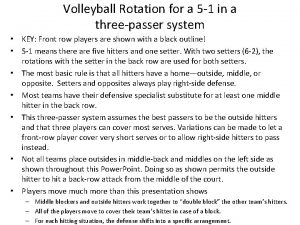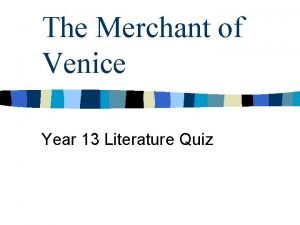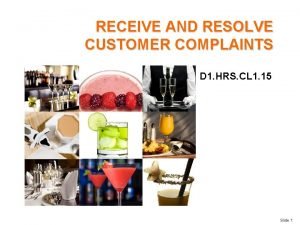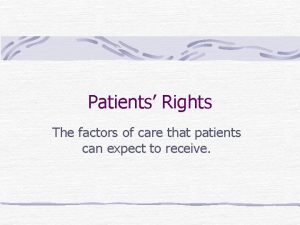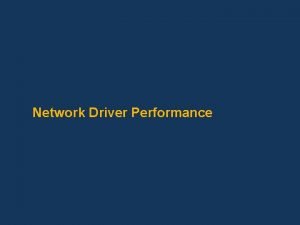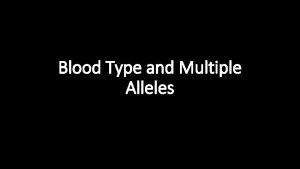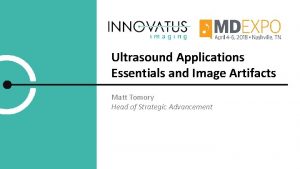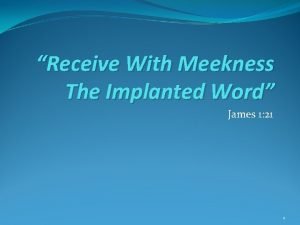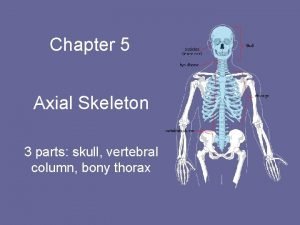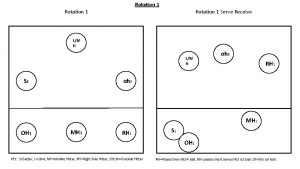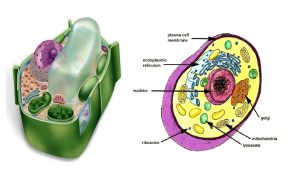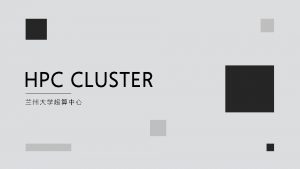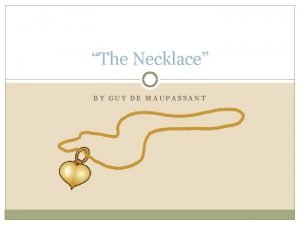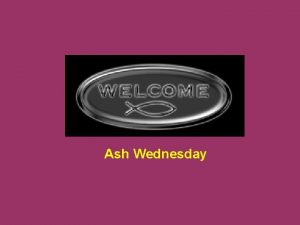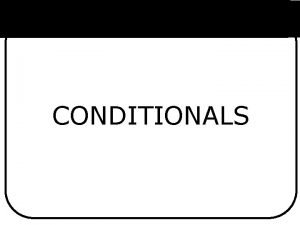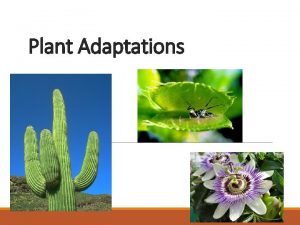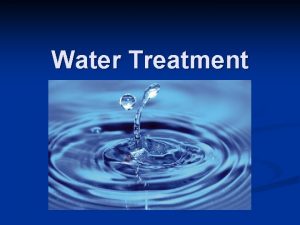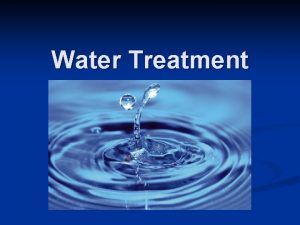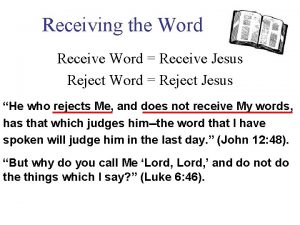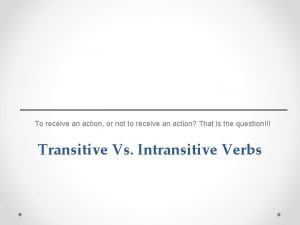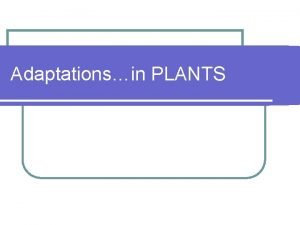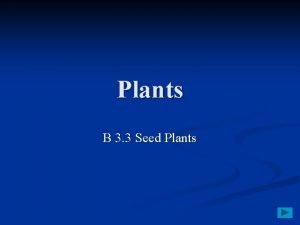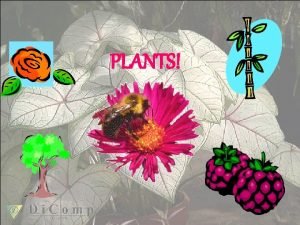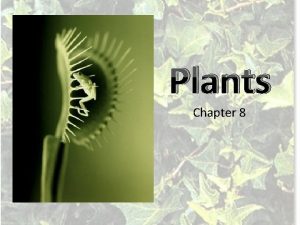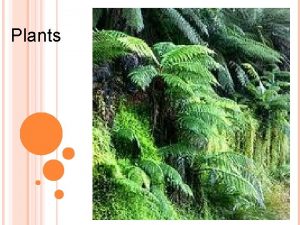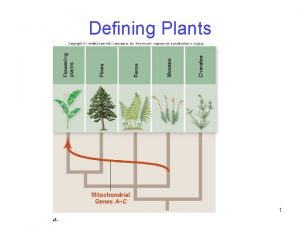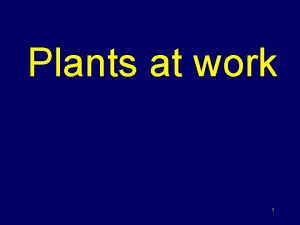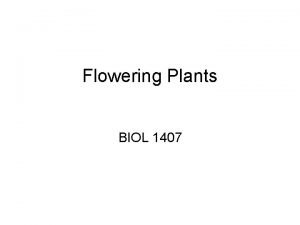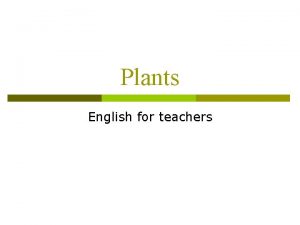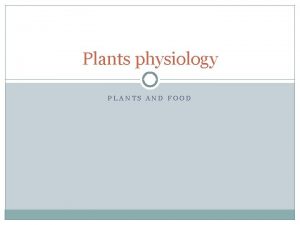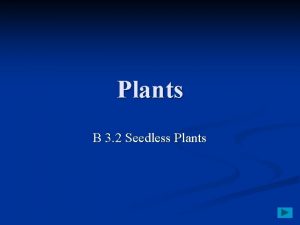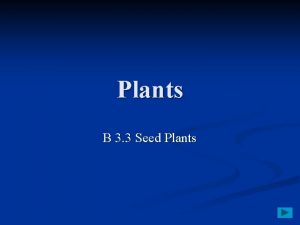Water Treatment Water treatment plants receive water from








































- Slides: 40

Water Treatment

• Water treatment plants receive water from different sources – rivers, lakes & reservoirs • 7 step process – screening, flocculation, settling, filtration, chlorination, fluoridation, p. H adjustment

Treatment Plant

1) Screening: • Water passes through large screens of wire mesh • This removes large suspended solids like branches, twigs or litter

Screening

2) Flocculation: • A flocculating agent called aluminium sulfate added to water • Acts as a coagulant – makes small suspended particles stick together and form large ones

Flocculation

3) Settling/Sedimentation: • Flocculated water pumped into bottom of large tanks • Water slowly rises to the top • Large suspended particles sink to bottom

Settling

4) Filtration: • Water passes from tanks through sand gravel beds • This removes any remaining suspended particles • Filter beds regularly cleaned

Filtration

5) Chlorination: • Chlorine added to sterilise water – killing any micro-organisms • Added in very small forms – just enough to keep water sterile • Added in form of chlorine gas or sodium hypochlorite

Chlorination

6) Fluoridation: • Fluorine added to help prevent tooth decay • Added in form of sodium fluorosilicate • Only added in some countries (incl. Ireland)

Fluoridation

7) p. H adjustment: • Tap water should be in range of p. H 6 – 8 • If p. H too low (too acidic) lime is added • If p. H is too high (too basic) sulfuric acid is added • If the p. H is too low it can cause pipes to corrode

p. H adjustment

Eutrophication • Eutrophication is the over-enrichment of water by nutrients like phosphates and nitrates • This is reason for tertiary stage of sewage treatment as it removes phosphates & nitrates

• Occurs when agricultural waste like fertiliser and animal slurry are dumped in water • Fertiliser and animal slurry are full of these nutrients • Use of fertiliser and control of dumping are vital to prevent this pollution

• The nutrients in the water act like fertilisers to plants and increase growth of plants and algae in lakes and rivers • Can see the algae bloom formed

Algae Bloom

• Algae do not live long • As they decay they consume the oxygen dissolved in the water • By using up this dissolved oxygen they cause the death of animal life (animals living in the water and those that rely on that water supply)

Heavy metal pollution • Heavy metals = metals with high relative atomic masses • Examples = mercury (Hg), cadmium (Cd) and lead (Pb) • Sources = car batteries or dry batteries

• Have started recycling batteries which will improve level of pollution • But if dumped in water can pass into drinking water • All these metals are poisonous and if build up in body can cause serious illness

• But before being dumped in water they can be removed • Removed by precipitation • There are different treatment processes for each metal

Water quality • Controlled by EU regulations • Limits have to be set because of toxic effects • Examples: Chemical: phosphates nitrates lead mercury Limit: 2. 2 p. p. m 50. 0 p. p. m 0. 01 p. p. m 0. 1 p. p. m

Sewage Treatment • Domestic sewage dumped untreated in waterways for years • Huge source of pollution to water supply • Some areas now have sewage plants to treat the effluent • 3 stage process – primary, secondary and tertiary treatment

Sewage Plant

Primary Treatment • Physical process • Screening and settling • Effluent passes through large wire mesh to remove large particles and break up sewage

• Passes through long grit channels on way to settling tanks to remove more particles • Grit channels regularly cleaned • Enters settling tank at bottom and slowly rises to top

• Sludge settles at bottom and is removed regularly • Machine skims surface of water to remove any floating particles • Effluent flows from top of tank on to secondary stage

Secondary Treatment • Biological process • Bacterial breakdown of nutrients in effluent • Effluent oxidised aerobically (in air) by a trickling filter OR an activated sludge unit

• Trickling filter – effluent passes through bed of stones containing micro-organisms that digest the nutrients

Trickling Filter

Trickling Filter

• Activated sludge unit – effluent passes into tank containing micro-organisms that digest the nutrients. Tank is kept oxygenated by a mechanical rotar

Activated Sludge Unit

• Aerobically digested effluent then passes into settlement tanks • It is now safe to pass into waterways where it will be diluted and less harmful to environment • But still contains nitrates and phosphates so moves on to tertiary stage

Tertiary Treatment • Removal of nitrates and phosphates • Very expensive process so not all plants carry out this stage • Removed by precipitation

• Phosphates react with aluminium sulfate (flocculating agent) and are removed by filtration • Nitrates removed by biological denitrification – effluent left in tanks with no air so uses the oxygen bonded to nitrogen in nitrates to digest effluent
 Nonvascular plant
Nonvascular plant Nonvascular plant diagram
Nonvascular plant diagram Flowering plants and non flowering plants similarities
Flowering plants and non flowering plants similarities Photosynthesis equation
Photosynthesis equation Water and water and water water
Water and water and water water Volleyball rotation positions
Volleyball rotation positions What reason does antonio give for being sad
What reason does antonio give for being sad Send recv mpi
Send recv mpi Receive and resolve customer complaints
Receive and resolve customer complaints The factors of care that patient can expect
The factors of care that patient can expect Receive side scaling
Receive side scaling Sinners jesus will receive
Sinners jesus will receive Can a+ receive a-
Can a+ receive a- But you shall receive power
But you shall receive power Receive
Receive Receive with meekness the implanted word meaning
Receive with meekness the implanted word meaning Chapter 5 the skeletal system axial skeleton skull
Chapter 5 the skeletal system axial skeleton skull Lady macbeth calls on supernatural powers to
Lady macbeth calls on supernatural powers to Unit 1 getting started
Unit 1 getting started Volleyball front zone
Volleyball front zone Guest request in housekeeping
Guest request in housekeeping Stream of praise i receive your love
Stream of praise i receive your love Confess repent believe receive
Confess repent believe receive Lesson 2 a letter from an english friend
Lesson 2 a letter from an english friend Exec cics web send
Exec cics web send Stacked membranes that receive store package
Stacked membranes that receive store package Let earth receive her king bible verse
Let earth receive her king bible verse 十字架上的光芒 温柔又慈祥
十字架上的光芒 温柔又慈祥 Clnt_create: rpc: unable to receive
Clnt_create: rpc: unable to receive For you shall receive power when the holy spirit
For you shall receive power when the holy spirit Prabu rambadran
Prabu rambadran 4 choose the correct item
4 choose the correct item Anticipation guide for the necklace
Anticipation guide for the necklace Trimester graphic organizer
Trimester graphic organizer The neuron process that normally receive incoming stimuli
The neuron process that normally receive incoming stimuli Do you say amen when you receive ashes
Do you say amen when you receive ashes Water movement in xylem
Water movement in xylem If you don’t water flowers, they
If you don’t water flowers, they Clareville water treatment plant
Clareville water treatment plant Water potential definition biology
Water potential definition biology Prairie plant adaptations
Prairie plant adaptations





